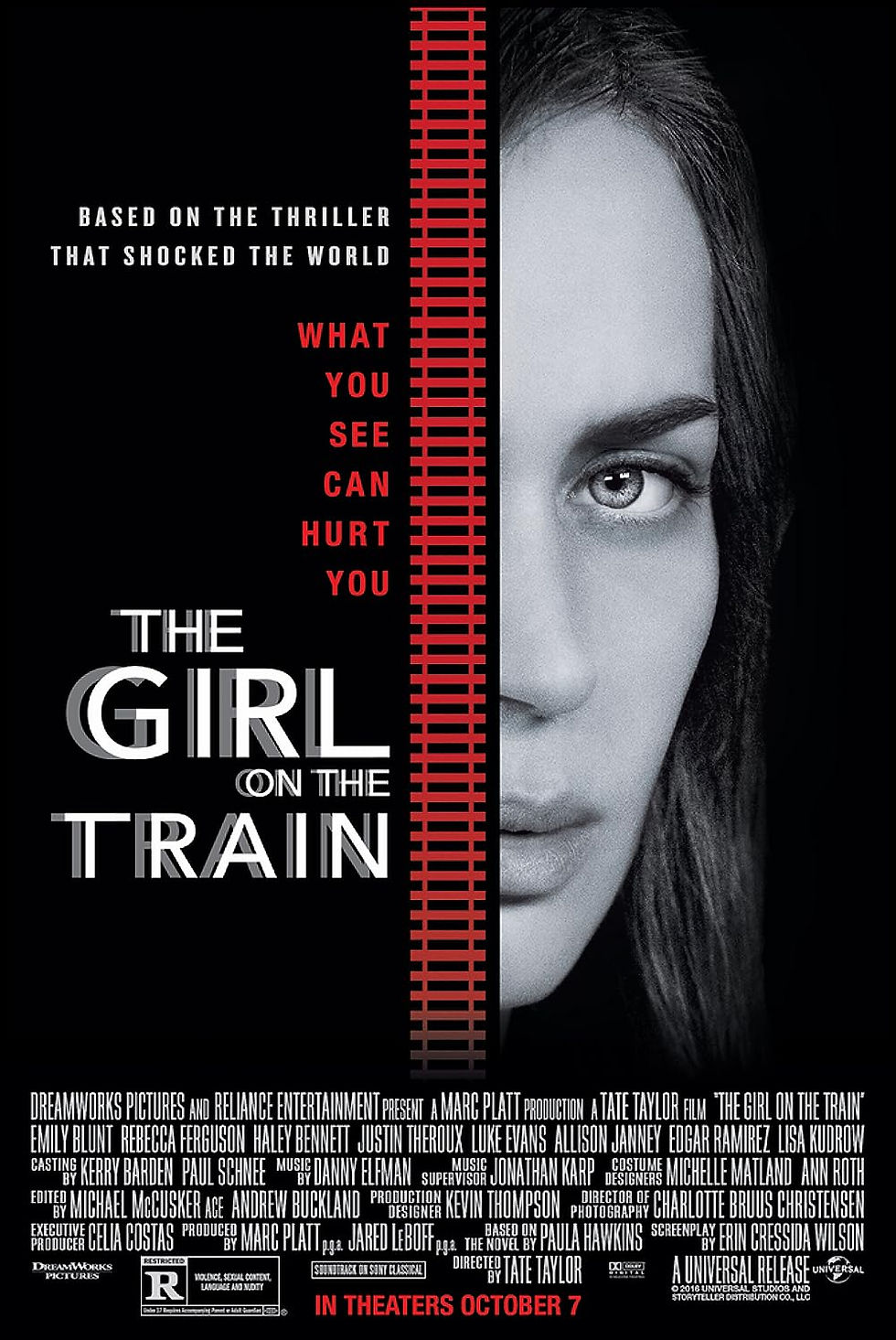Book Vs Movie: The Girl On The Train
- Graphic Grim Reader
- May 16, 2024
- 4 min read
Updated: May 18, 2024
When it comes to "The Girl On The Train," the book and the movie share some striking similarities. Firstly, both follow the central character, Rachel, as she becomes entangled in a complex web of lies, deceit, and murder. The core storyline, revolving around Rachel's obsession with a seemingly perfect couple she observes from the train, remains consistent across both mediums.
Moreover, the themes of addiction, trauma, and unreliable narration are prevalent in both the book and the movie. Rachel's struggle with alcoholism and her unreliable memory serve as central plot points in both versions, adding layers of complexity to her character and the narrative as a whole.
Overall, while there may be differences in the execution and pacing, the fundamental story and themes remain remarkably similar between the book and the movie adaptation of "The Girl On The Train." Both offer a gripping tale of psychological suspense and intrigue that keeps audiences guessing until the final reveal. But here we're going to talk more about how they differ and what worked for each medium even though they differ.
Start with the specs
BOOK VS MOVIE
BOOK
Title: The Girl on the Train
Genre: Fiction, Mystery
Audience: Adults
Page Count: 326
Author: Paula Hawkins
ISBN: 9780735219755
Publisher: Riverhead Books
MOVIE
Title: The Girl on the Train
Director: Tate Taylor
Distributed By: Universal
Casting and Performances
One of the most notable aspects of the movie adaptation is the casting of Emily Blunt as Rachel Watson. Blunt's portrayal is widely regarded as one of the film's strengths. She captures the essence of Rachel’s troubled, complex character with a nuanced performance that conveys her vulnerability and desperation. Blunt’s ability to convey the pain and confusion of Rachel’s experiences makes her a perfect choice for the role.
Tone and Themes
While the book is a psychological thriller that delves deeply into the unreliable narrative of its protagonist, the movie takes a slightly different approach. The book focuses more on Rachel's internal struggles, the theme of memory, and the consequences of alcoholism. The movie, however, introduces a more hyper-sexualized tone, which can feel at odds with the original narrative's subtlety. This choice alters the film's atmosphere, making it seem more like a conventional thriller than the nuanced psychological exploration found in the book.
Setting
One of the primary differences between the book and the movie is the setting. Paula Hawkins' novel is set in the UK, which is integral to the story’s mood and character dynamics. However, the film relocates the story to the United States. This change impacts certain cultural references and the overall feel of the story. While the core plot remains the same, the setting shift can be jarring for fans of the book.
Plot and Character Development
The book’s narrative is complex, with multiple perspectives and a non-linear timeline that adds to the suspense. Rachel, Megan, and Anna each provide their viewpoints, allowing readers to piece together the story gradually. The movie simplifies this narrative structure, primarily focusing on Rachel’s perspective. This change makes the story more straightforward but also loses some of the depth and intricacy that made the book compelling.
Another significant difference is in the character development and backstories. The book provides more detailed insights into the characters’ pasts and motivations, particularly Rachel's struggle with infertility and alcoholism. These elements are more briefly touched upon in the film, which may leave viewers with a less comprehensive understanding of her character.
Movie Pros
Gaslighting
One of the standout aspects is the slow reveal of crucial information, particularly regarding Rachel's ex-husband, Tom. The film adeptly portrays how Tom gaslights Rachel, manipulating her memories and perceptions to maintain control over her. Through subtle cues and nuanced performances, viewers gradually uncover the extent of Tom's manipulation, adding layers of tension and intrigue to the narrative. This slow-burn approach not only heightens suspense but also underscores the themes of gaslighting and psychological manipulation present in the story.
Living Arrangements
Rachel's relationship with her roommate is portrayed as more strained compared to the book. The film highlights Rachel's inability to be trusted through her interactions with her roommate, amplifying the sense of isolation and instability in her life. The heightened tension between the characters underscores Rachel's struggle with alcoholism and unreliable behavior, further emphasizing her status as an unreliable narrator. By emphasizing the strained relationship with her roommate, the movie effectively underscores Rachel's internal turmoil and adds to the overall sense of suspense and unease in the narrative.
Book Pros
The book is always better
In my opinion, the book version of "The Girl on the Train" holds the edge over its cinematic counterpart. While I don't necessarily have an issue with a story containing elements of sensuality, my preference lies in immersing myself in the mystery and thrill of the narrative. The book, in this regard, aligns more with my preferred style of storytelling. Unlike the movie, which at times leaned towards being overly sexualized, the book maintains a focus on the intricate layers of the mystery and the psychological depth of the characters. This allows readers to delve deeper into the complexities of the plot and the intricacies of the characters' inner lives, resulting in a more satisfying and engaging reading experience.
Book vs Movie
Both the book and movie versions of "The Girl on the Train" offer their own unique interpretations of the gripping thriller. While the movie benefits from stellar performances and visually captivating scenes, the book excels in its ability to delve into the psychological depths of its characters and maintain a focus on the intricacies of the mystery. Ultimately, whether you prefer the immersive experience of reading the book or the cinematic spectacle of Emily Blunt as Rachel, "The Girl on the Train" continues to captivate audiences with its gripping narrative and compelling characters.
Book images are always links for quick access to












Comments